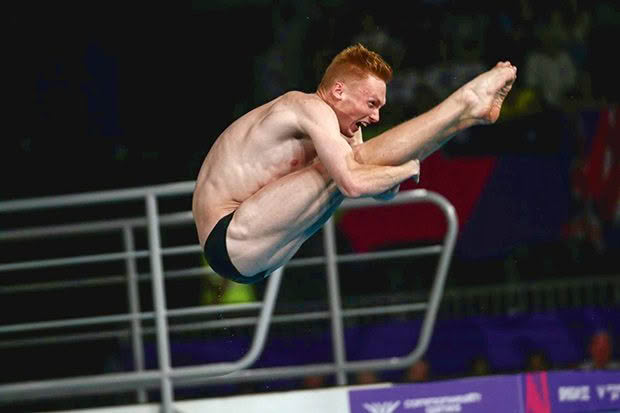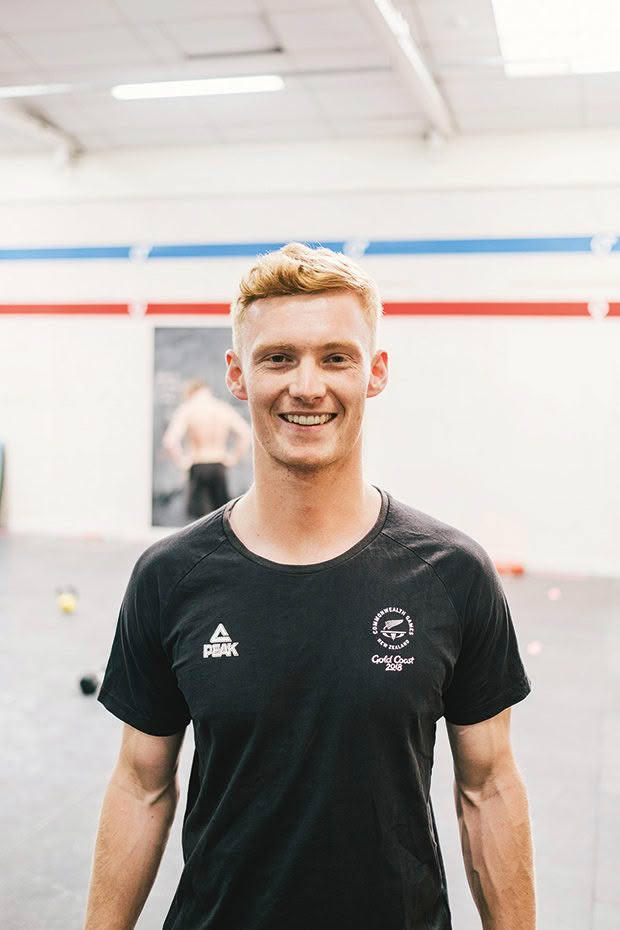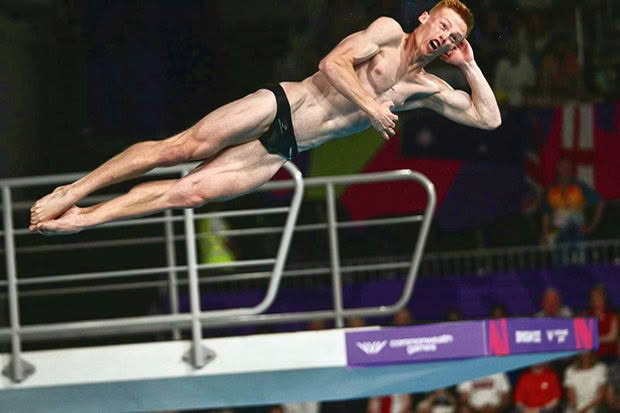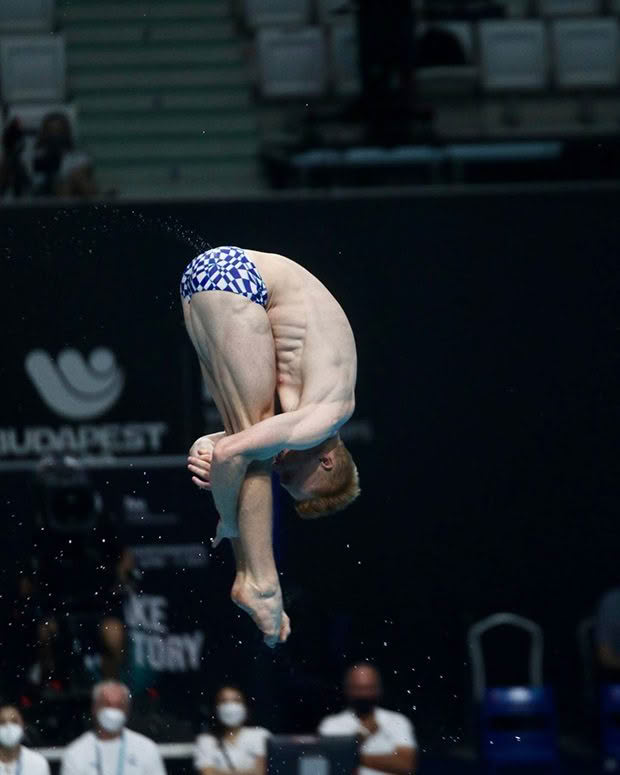A dive may be over in a matter of moments – but it takes hours to perfect

Diving is a study in time and motion, breath-taking synchronicity of mind and body. The aim, as always, is perfection.
Words: Heather Kidd Photos: The NZ Team
It’s over in a matter of seconds. Striding to or launching oneself from the end of the board, inwards or forwards, complex quicksilver manoeuvres, somersaults or twists — sometimes both — tucks and pikes. Up, always up… then the rapid descent, the body like a spear — toes pointed, hands clasped — as it slices through the surface of the water.
So much effort is required to make it look effortless.
For springboard specialist Liam Stone, 26, a veteran of three Commonwealth Games, including Birmingham 2022, where he achieved top 10 results, effort is not something reserved solely for the dive. It takes effort, in the form of self-control, during the pre-dive process to not overthink what he’s about to do. Such is the technical difficulty of the sport; success is not guaranteed no matter how long or hard a diver has practised. Fear of the dive and of failure is a feeling that requires effort to suppress.
As Liam climbs the ladder to the board, he is intent on clearing his mind, trying not to think about much at all. By this stage, he’s already visualized the dive he’s about to execute, and the next step is to allow his body to take over, to do the work.

“A dive happens extremely fast, and it’s a bit of a blur. There’s a big physical strain during the take-off as I try to get as much height as possible, and then I must get into a small shape quickly so I can begin my rotations — the smaller you are, the faster you’re going to spin.”
While spinning, Liam is looking for his spot or reference point. “Let’s say I’m doing three-and-a-half somersaults… As I’m rotating, I’ll see it once, twice, and at the third time, I know to come out of that shape, kick out of the dive and grab my hands in readiness to enter the water.”
For Auckland-born and bred Liam, being in or near the water was a big part of childhood, just as it is for many Kiwi kids. But unlike his contemporaries, he had an older half-brother in Canada who made that country’s national dive team. Nick Lachance’s success sparked a desire in Liam to give the sport a go.
Liam started diving when he was seven, and although he quickly proved to be more than competent, he did have one issue to overcome — fear. “I was quite scared for a long time. I can’t pinpoint exactly why that was because I was quite good at diving from the get-go, and I’d always enjoyed being in the water — jumping into it, doing bombs, typical kids’ stuff. But learning to dive from a diving board — when you’re a kid, they seem very high — was quite scary. I was fortunate to have Nick as a mentor to help me through those periods of being afraid.”
Nearly 20 years on, Liam has made peace with the fear factor and appreciates it’s a feeling worthy of respect. “If you’re not scared, there’s probably something wrong with you. It also adds to the rush, and it feels good when you overcome something that scares you.”

At Birmingham, the dive that got Liam’s pulse racing more than any other was the reverse two-and-a-half pike. “I tend to get intimidated by the reverse direction, partly because you’re spinning with your head back towards the board. It was my favourite dive to do well at the games, and I felt great when I conquered it.”
In his future await other daunting dives —he is keen to add the three-and-a-half tuck and the forwards four-and-a-half somersaults to his repertoire. Perfecting these dives will be paramount if he is to realize his goal of competing at the 2024 Olympic Games in Paris. It also means he has stepped away from his real estate career to focus solely on diving.
Liam trains between 20 and 25 hours a week in the pool and doing what is termed dryland training, which can involve a trampoline, flipping onto crash mats or using a dry board, which is like diving onto a mat rather than water. Harnesses or rigs are helpful when practising somersaults. A system that produces large bubbles helps soften entry into the water when training in a pool. Regular physiotherapy and recovery sessions are also in the schedule — their importance cannot be overstated. Liam has had to cope with significant injuries, including a back injury that stopped him diving for 18 months, and burnout.
“The past five years have been particularly tough. There was a time I wasn’t sure I’d ever be able to dive again. The main thing I’ve learned from the experience is how to overcome adversity. Also, sport is the opposite of instant gratification — it’s about setting a goal and working towards it. It can be tough, you may have to do things you don’t want to, but it’s about keeping the bigger picture in mind, being tenacious. Sport exposes you to something you can’t get elsewhere, that of pushing yourself to your limits.”
Liam likens diving to golf, both sports requiring body and mind to be in sync. “Golf is about your position, club speed and swing. You’re not thinking about the individual elements when it all comes together. It just happens; it’s part of the subconscious. As soon as you strike the ball, you know without even seeing where the ball’s gone whether it’s a good shot or not. It’s the same with diving. Instantly I know if I’ve nailed the take-off, and when I go through the water, I know if it was a good dive.”
Seeking perfection is a never-ending quest — and Liam’s already had a taste of it. In 2015, while a student at the University of Tennessee competing in his first major competition, he scored [perfect] 10s doing a reverse two-and-half-somersault. That moment of perfection is what he hopes to emulate on the world stage.
SOUND OF SUCCESS

As they enter the water, every diver hopes to hear the rip, which in diving parlance is a distinctive sound like the ripping of paper that indicates the dive is a good one. According to Liam, it’s akin to the golfing sweet spot, the sound of the ball hitting the club in a perfectly struck shot.
Hearing the rip tells the diver the alignment of their body has been perfect. It means their hands were perpendicular to the water upon entry, and their body maintained the same line.
How cleanly a diver enters the water is important. “The entry is the last thing the judges see, and if a dive finishes with no splash, it’s impressive,” says Liam. “While the entry is not the only thing the judges are looking at, it plays a significant part in your score.”
HOW DIVES ARE SCORED
Individual diving events are scored by seven judges, who rely solely on their eyes and memory, awarding divers marks out of 10. The criteria for judging a dive are:
0 = failed
0.5-2 = unsatisfactory
2.5-4.5 = deficient
5-6.5 = satisfactory
7-8 = good
8.5-9.5 = very good
10 = excellent
Once all marks are collated, the highest and lowest two scores are discarded. This is done to ensure there is no possible manipulation of scores by the judging panel. The remaining scores are tallied and then multiplied by the dive’s degree of difficulty — which considers body position, the number of somersaults, twists etc — to arrive at a final score.
Synchronized diving events have a panel of 11 judges. Six judges — three per diver — mark the execution of the dive while the other five focus on the duo’s synchronization.
Love this story? Subscribe now!
 This article first appeared in NZ Life & Leisure Magazine.
This article first appeared in NZ Life & Leisure Magazine.
